Updated and dedicated as per personal communication with Shelby Johnson, August 19, 2022
Updated as per BAMONA, August 19, 2022
Greene County, New York, and Nearby Counties:
Columbia, Dutchess, Queens and Rensellaer
Sphingidae
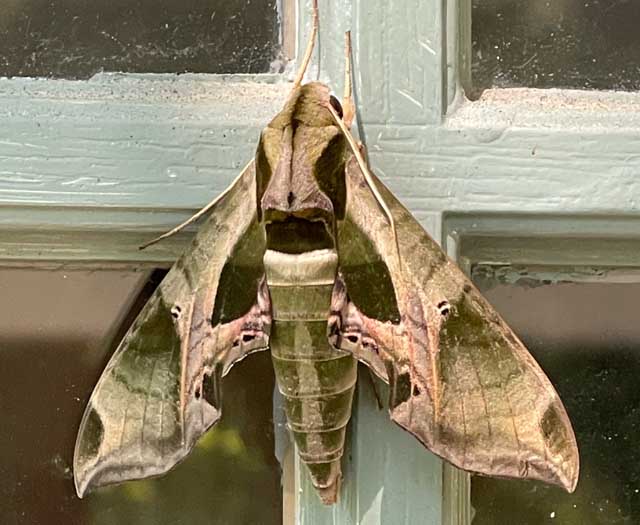
Eumorpha pandorus, Dutchess County, New York,
August 18, 2022, courtesy of Shelby Johnson.
Forty-six Sphingidae species are listed for New York on the U.S.G.S. (2006) (now BAMONA with 47 species listed, 2022)
website. Not all of the species are reported or anticipated in Greene County (only one is currently (June 2006) reported on U.S.G.S.:
Lapara bombycoides). It is hoped that this checklist, with the thumbnails and notes, will help you
quickly identify the moths you are likely to encounter.
A "WO" after the species name indicates that I have no confirmed reports of this species in Greene County, but I
(William Oehlke) expect that this moth is present.
A "BAMONA" indicates the moth is reported on the USGS (BAMONA) website and/or in
Lepidoptera of North America, #1. Distribution of Silkmoths (Saturniidae) and Hawkmoths (Sphingidae)
of Eastern North America, an excellent little booklet available through Paul Opler.
Although this file was originally created for Greene County, it also serves as a valid checklist for nearby counties: Dutchess,
Columbia, Rensellaer and Queens.
Here is a breakdown of what is reported on BAMONA as of August 19, 2022:
Greene County: Lapara bombycoides; Sphinx kalmiae Smerinthus cerisyi; Hyles gallii.
Columbia: Lintneria eremitus; Lapara bombycoides; Lapara coniferarum; Manduca sexta; Sphinx drupiferarum; Sphinx poecila;
Pachysphinx modesta; Paonias excaecata; Hemaris thysbe; Darapsa myron; Deidamia inscriptum; Hyles gallii; Sphecodina abbottii.
Dutchess County: Ceratomia amyntor; Ceratomia undulosa; Lintneria eremitus; Amorpha juglandis; Paonias excaecata; Smerinthus jamaicensis;
Hemaris diffinis; Hemaris thysbe; Amphion floridensis; Darapsa myron; Hyles euphorbiae; Hyles gallii; Hyles lineata; Sphecodina abbottii.
Queens County:Ceratomia amyntor; Ceratomia undulosa; Dolba hyloeus; Lapara coniferarum;
Manduca rustica; Manduca sexta; Paratrea plebeja; Sphinx chersis; Sphinx kalmiae; Sphinx luscitiosa;
Amorpha juglandis; Paonias excaecata; Paonias myops; Smerinthus jamaicensis;
Enyo lugubris; Hemaris diffinis; Hemaris thysbe; Eumorpha achemon; Eumorpha pandorus; Amphion floridensis; Darapsa choerilus (pholus); Darapsa myron;
Deidamia inscriptum; Hyles lineata.
Rensselaer County: Ceratomia undulosa; Manduca sexta; Pachysphinx modesta; Paonias excaecata; Paonias myops;
Hemaris diffinis; Hemaris thysbe; Eumorpha pandorus;
Darapsa myron; Deidamia inscriptum; Hyles gallii; Sphecodina abbottii.
This page is dedicated to Shelby Johnson who provides the Eumorpha pandorus image at top of page. It has also been updated for all
counties mentioned, and with images of live moths
when available as of August 18, 2022.
Please help me develop this list with improved, documented accuracy by sending sightings (species, date, location), preferably with an
electronic image, via email to Bill Oehlke. Please also send your sightings to BAMONA, an excellent resource.
Visit Sphingidae of the Americas to access similar Sphingidae lists for all US states and counties, all Canadian provinces,
Mexico, all Central and South American countries. For many of the US counties there are larvae thumbnail checklists available via the individual state files.
Visit North American Catocala to access pictoral checklists for Catocala
(underwing moths) for all US states and all Canadian provinces.
Sphinginae subfamily
Sphingini tribe:
 |
Agrius cingulata
WO
stray
Pink-spotted Hawkmoth.
This moth is a very strong flier, but would only make its way to
Greene County as a rare stray. There are not too many records from
New York state, but records exist for NJ & CT.
|
 |
Ceratomia amyntor
WO/Dutchess/Queens/,
Elm Sphinx or Four-horned Sphinx.
Larvae feed on Elm (Ulmus), birch (Betula), basswood (Tilia), and
cherry (Prunus). |
 |
Ceratomia undulosa
WO/Dutchess/Queens/ Rensselaer. Waved
Sphinx. I have seen them as far north as P.E.I. in
eastern Canada, and took them in New Jersey.
It is named for the
wavy lines on the forewings. |
 |
Dolba hyloeus
WO/Queens/, Pawpaw Sphinx.
The upperside of the forewing is dark brown with a dusting of white scales. Some moths have patches
of reddish or yellowish brown on the wings.
|
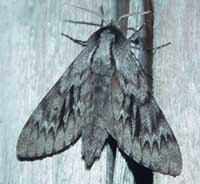 |
Lapara bombycoides
BAMONA; Greene County/Columbia, Northern Pine Sphinx.
The upperside of the forewing is gray with heavy black bands. The
upperside of the hindwing is
brownish gray with no markings.
|
 |
Lapara coniferarum /Columbia/Queens County, Southern Pine Sphinx.
this moth is reported from Richmond, and it is widely reported in
New Jersey and along the coast in Connecticut and Masachusetts.
If you've got pines, this species is likely present. |
 |
Lintneria eremitus
WO/Dutchess County/Columbia
Hermit Sphinx.
The upperside of the forewing is gray-brown with wavy lines, black
dashes, and one or two small white spots near the center of the
costa. |
 |
Manduca quinquemaculata
WO,
Five-spotted Hawkmoth.
Abdomen usually has five but sometimes six pairs of yellow
bands. Forewing blurry brown & gray. Hindwing banded with brown & white & has two
well-separated median zigzag bands.
|
 |
Manduca rustica
rustica /Queens County. Rustic Sphinx.
I would not be surprised to get a report. Look for three large yellow spots
on each side of the abdomen.
|
 |
Manduca sexta
WO/Columbia/Queens County/ Rensselaer. Carolina Sphinx.
If you grow tomatoes, however, you have probably encountered it.
Larvae get very large and can strip a tomato plant.
|
 |
Paratrea plebeja
WO/Queens County/, Plebeian Sphinx
Forewing gray with indistinct black and
white markings. Series of black dashes
from base to tip, & small white cell spot. North of
normal range!
|
 |
Sphinx chersis
WO/Queens/, Northern Ash Sphinx or Great Ash Sphinx
Might present but may not be common. Larval hosts are ash, lilac, privet, cherry, and quaking aspen.
|
 |
This species is not officially reported in Greene County. We have them
on P.E.I., but I do not see them nearly as frequently
as I see the other Sphingidae. |
 |
Sphinx kalmiae
Greene County/Queens/, Laurel Sphinx.
Lower forewings predominantly brownish-yellow with fairly
wide dark bar along inner margin. At rest wings hug body,
giving moth long slender look.
|
 |
Sphinx luscitiosa
WO/Queens/,
the Canadian Sphinx or
Clemen's Sphinx,
This one is reported from Suffolk and Richmond and from
northeastern New Jersey and might be present in Greene County.
|
 |
Sphinx poecila
WO/Columbia/ Poecila Sphinx.
If you have blueberries in woods, you might have
Poecila Sphinx. Pretty common here on Prince Edward Island,
but don't fly too far south of Massachusetts, being replaced by
Sphinx gordius in Connecticut. |
Smerinthini Tribe:
 |
Amorpha juglandis
WO/Dutchess County/Queens County/,
Walnut Sphinx
This is the first Sphinx species I reared as a boy in New Jersey.
See the file for the female; she is different. |
 |
Pachysphinx modesta
WO/Columbia/Rensselaer.
Modest Sphinx or Poplar Sphinx.
Larvae feed on poplars and willows.
They are common on Prince Edward Island. Very heavy body! |
 |
Paonias excaecata
WO/Dutchess/Columbia/Queens/ Rensselaer.
Blinded Sphinx.
Named for dull grey-blue spot (minus dark pupil) in hindwing,
Wide distribution probably common in Greene County.
I regularly see them on Prince Edward Island, and they are reported
as far south as Florida. |
 |
Paonias myops
WO/Queens/ Rensselaer. Small-eyed Sphinx.
Named for small eye-spot in hindwing, wide
distribution; probably common in Greene County. I regularly see them on Prince Edward Island, and they are reported
as far south as Florida.
|
 |
Smerinthus cerisyi
Greene County, Cerisyi's Sphinx.
Greene County would be close to the southern limit for this species in New York.
I never saw one in New Jersey. At my home in Montague, P.E.I., Canada, they are quite common. |
 |
Smerinthus jamaicensis
WO/Dutchess/Queens .
Twin-spotted Sphinx.
Widely distributed; fairly common.
Along the East Coast, it flies from P.E.I. to Florida. It probably
flies in Greene County. |
Macroglossinae subfamily
Dilophonotini tribe:
See Hemaris comparison to help distinguish
the next three species.
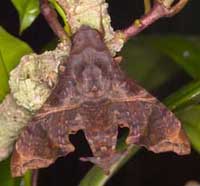
|
Enyo lugubris, Mournful Sphinx,
Queens County.
Body & wings dark brown. Forewing: large black
patch covering most of outer half of wing. Pale
tan cell spot (dark inner pupil), & fairly straight median line
to inside of cell spot. rare stray
|
 |
Hemaris thysbe
WO/Dutchess/Columbia/Queens/ Rensselaer.
Hummingbird Clearwing.
Day flier is not thus far reported in Greene, but
is widely reported to the north, east, south and west.
They are widely distributed in the east from P.E.I. to Florida. |
 |
Hemaris diffinis
WO/Dutchess County/Queens County/ Rensselaer.
Snowberry Clearwing or Bumblebee Moth.
This moth is widespread but has not been recorded in Greene County
although reported in northwestern N.J. and southeastern N.Y. and
Connecticut.
|
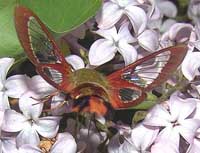 |
Hemaris gracilis WO,
Slender Clearwing or Graceful Clearwing.
This day-flying moth is less common and has not been recorded in
Greene, but has been seen due east, south and west. Questionable.
|
Philampelini tribe:
 |
Eumorpha achemon
WO/Queens , Achemon Sphinx.
Often reported along the coast from southern New Jersey to central Maine.
Note the differences between this moth and Pandorus Sphinx. |
 |
Eumorpha pandorus
WO/Dutchess; SJ/Queens/ Rensselaer. Pandorus Sphinx.
If you have Grape or Virginia Creeper nearby, then you probably have
this species. I often get asked to identify larvae from areas not previously reported. |
Macroglossini tribe:
 |
Amphion floridensis
WO/Dutchess County/Queens County/,
Nessus Sphinix.
Day flier, widely distributed. If you have Virginia Creeper, you
probably have the Nessus Sphinx. Two bright, distinct, narrow yellow
bands are often visible on the abdomen.
|
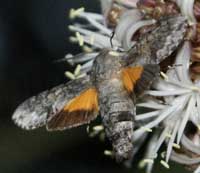 |
Cautethia grotei
WO,
Grote's Sphinx.
This species is rarely recorded in the U.S., but there are sightings in the east
from Florida, South Carolina, New Jersey, New York, Massachusetts and
New Hampshire. There are no reports from Greene. Very Questionable!
|
 |
Darapsa choerilus
WO/Queens/font> Azalea Sphinx.
Common in New Jersey; common
here on Prince Edward Island.
You will often see this species listed as Darapsa pholus,
especially in older literature.
|
 |
Darapsa myron
WO/Dutchess/Columbia/Queens/ Rensselaer.
Virginia Creeper Sphinx or Grapevine Sphinx.
Widely reported as far north as southern Maine. If you have the
foodplants indicated in the common names, you probably have this
species nearby. |
 |
Darapsa versicolor
WO,
Hydrangea Sphinx.
If you have hydrangea growing near a stream, then you may have the
Hydrangea Sphinx.
|
 |
Deidamia inscriptum
WO/Columbia/Queens County/ Rensselaer.
the Lettered Sphinx
This species has not been recorded in Greene County,
but it is likely present.
|
 |
Hyles gallii
Greene/Dutchess/Columbia/ Bedstraw Hawk Moth
or Gallium Sphinx. I suspect it might be rare. Some years I see them on P.E.I., some years, I do not.
|
 |
Hyles lineata
WO/Dutchess County/Queens County/ Rensselaer.
White-lined Sphinx.
This species flies across southern New York and has strong migrating tendancies.
There are records from New Hampshire and Maine. |
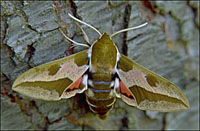 | Hyles euphorbiae Dutchess County,
possibly a recording or identification error; introduced from Europe to northwestern states to try to
control leafy spurge plant. Perhaps it has spread to New York. |
 |
Sphecodina abbottii
WO/Dutchess County/Columbia. Abbott's Sphinx.
This moth is very much under reported across the United States. It
is a rapid day flier so is probably not in too many collections.
Grape is a popular larval
|
|
|
Enjoy some of nature's wonderments, giant silk moth cocoons.
These cocoons are for sale winter and fall. Beautiful Saturniidae moths will emerge the following spring and summer.
Read Actias luna rearing article.
Additional online help available.
Eggs of many North American species are offered during the spring and summer. Occasionally
summer Actias luna and summer Antheraea polyphemus cocoons are available. Shipping to US destinations is done
from with in the US.
Use your browser "Back" button to return to the previous page.
This page is brought to you by
Bill Oehlke and the
WLSS. Pages are on space rented from Bizland. If you would like
to become a "Patron of the Sphingidae Site", contact Bill.
Please send sightings/images to Bill. I will do my best to respond to requests for identification help.
 | 
Show appreciation for this site by clicking on flashing butterfly to the left.
The link will take you to a page with links to many insect sites. |








































